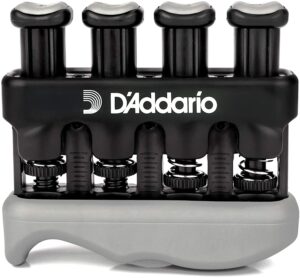Today we’re going to be covering “will guitar calluses will ever go away?” The short answer to this question is yes they will go away. It takes time for you to build calluses with guitar playing. Many beginners find that the callus buildup will accumulate when they’re first beginning to learn how to play guitar. Thicker guitar strings will also help you build calluses quite a bit faster.
Table of Contents
Guitar Calluses Are Like the Name of the Game
The first thing I wanted to mention is that calluses are almost unavoidable for beginners to start accumulating because your fingertips are getting adjusted to the tension and the movement you’re putting on the guitar strings. Certain techniques such as bending and sliding can help the callus buildup develop faster. The first thing you’ll notice when you’re developing calluses is maybe fingertip pain. You can avoid a lot of this pain by putting less tension on the guitar strings and moving your fingers closer to the frets. Putting your finger closer to the fret will also create less fret buzz. You only need to put moderate pressure as this will create less pressure on your fingertips and in addition, it will also create less pain on your fingertips. Many believe that you need to put a ton of pressure on the strings to produce the best sound and avoid fret buzz. This simply isn’t true. Too much pressure can cause intonation problems with the actual note you are trying to play.
Guitar Callus Buildup Takes Time – 1 to 2 Months
Guitar callus buildup takes time. Typically I noticed that when I started playing guitar the callus buildup was accumulating over a span of a month and then it stopped. It buildup skin over your fingertips and you just leave the skin alone and do not try to pick at it it’s just your body’s natural reaction to the pain from the pressure on your fingertips on strings. You will really know if you’re putting too much tension on the strings if the strings leave huge indentations in your fingertips and they take a long time to go away. I will say that those indentations are still a part of playing guitar.
If you’re a beginner and just starting out to avoid the pain and the callus buildup I’d recommend that you play guitar less in volume. Maybe around 15 to 30 minutes if you want to break out of even more maybe every 3 days. this is only if you’re trying to avoid the pain from finger build up. I will let you know that this build-up calluses will eventually go away and after about a month or two you will start to notice a lot less finger pain and callus buildup will not be nearly as likely.
Guitar/Hand Finger Grip Strengthening
Another thing you may be experiencing is hand pain or finger pain at the joints this may be due to improper technique or my guitar or it may be due to finger weakness. There are a number of exercises you can do to strengthen your hand and finger strength. Tou can buy these hand and finger grip strengtheners. They also sell callus buildup I’m / finger strengtheners from companies like the Daddario and I’ll put a link here if you’re interested in getting one.

Side Effects of Guitar Calluses
Common side effects you may notice are fingertip pain, dead skin cells flaking off, hardness on your fingertips, and maybe some numbness on your fingertips these are almost completely normal and part of the callus development process. Just like a gymnast or working out on an outside gym on the metal bar, it’s almost part of the process of developing these calluses.
After about a month or two of playing guitar start to notice less and less callus build-up, less finger pain, and numbness. If you put down the guitar, quit playing, and then pick up the guitar again, you may notice an initial onset of finger pain and callus build up as your fingers are getting adjusted to the guitar playing again.
If you start noticing blisters when you’re playing guitar, I would recommend quitting playing and let the blisters heal. It’s not good to let those bursts or cause more pain on your fingertips to check your good break and enjoy your time off to play better even better the next time
Acoustic Guitar vs Electric Guitar vs Classical Guitar Callus Buildup
Acoustic Guitar Strings
The acoustic guitar is probably going to be the best option for you if you’re trying to speed up the calluses buildup process. Heavier gauge strings are also going to speed up the process. Lighter gauge strings are not as hard to press down and so you may notice calluses that take longer to develop. Acoustic guitar strings are made out of metal. The top two strings are typically made out of steel and the bottom four strings are steel and could be coated and wrapped with phosphorus bronze or some other type of material.
Electric Guitar Strings
Electric guitar strings are thinner gauge but typically you see more bending and sliding techniques used on the electric guitar. You can still build calluses but it’s can be a slower process since the strings aren’t as heavier of a gauge as compared to an acoustic guitar.
Classical Guitar Strings
Classical guitar strings are made on nylon and they are softer. Classical guitar strings will not be as effective and will take much longer to develop calluses or see any type of finger pain.
Finger Pain Playing the Guitar
If you are concerned about finger pain, one of the causes of that may be because of having to put a lot of pressure on the guitar strings. Some things you can do to avoid having to put less pressure on it is to adjust the action of the guitar. Granted, you need to be careful to not adjust the action too much because when you play the guitar the open the strings may be too close to the frets and those vibrating strings may hit the fret and you strum your guitar. Keep in mind that fret buzz may happen for other reasons besides this. Some other common reasons for fret buzz may be a bad nut or a bad bridge on your guitar.
Guitar Calluses Will Eventually Go Away
Things I’ve noticed is that calluses are not a permanent problem. They will eventually go away. You may notice on certain days whether you’re gigging or practicing for many hours during the day that you build up a lot more calluses. This is pretty normal for playing guitar. The best advice I could give is to keep playing and don’t put down the guitar for months on end and then pick it back up again if you want to avoid this. Even after I quit playing the guitar for many months the fingertip strength came back very quickly. I did not have calluses buildup again but I did notice a little bit of fingertip pain. As always guys take it easy, listen to your body, and don’t push yourself so hard that you are in way too much discomfort for yourself. If you want some relief and you still want to play guitar you can switch to a classical guitar and play on some softer nylon strings.
Which hand will I typically notice more buildup?
That completely depends if your right or t left kind of player and if you’re playing finger-picking style or using a pick. Aggressive fingerstyle guitar playing are if you are a right-handed guitar player, you may notice that you are developing calluses on your right fingertips as well as your left-hand fingertips. As I already stated, most of the guitar calluses that are going to come from pressing down on the fingerboard with your fingertips for the chords and notes you want to produce.
Conclusion
To your question “will guitar calluses ever go away?” The answer is yes and in the long-term guitar playing, you will develop more resistance to further calluses and able to develop more strength in with your fingers. This process is almost part of playing guitar. I’m going to let you know that it is not a forever situation. Keep On Rockin’!
